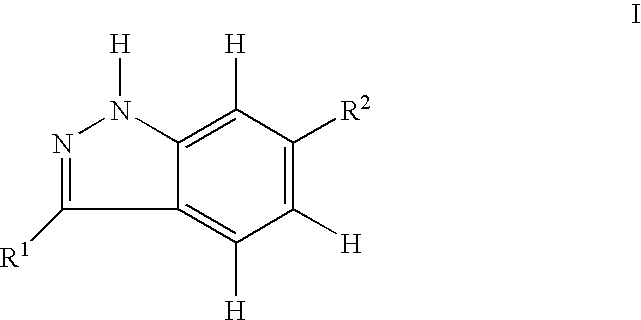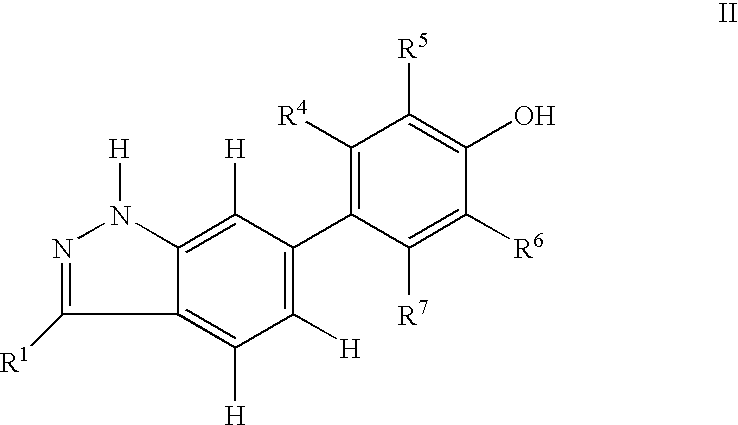Indazole compounds and pharmaceutical compositions for inhibiting protein kinases, and methods for their use
a technology which is applied in the field of indazole compounds and pharmaceutical compositions for inhibiting protein kinases, and methods for their use, can solve the problems of increasing vascular permeability and ultimately edema in the surrounding tissues, limited angiogenesis, and many secondary complications afflicting these patients, so as to enhance the antitumor effect and enhance the therapeutic
- Summary
- Abstract
- Description
- Claims
- Application Information
AI Technical Summary
Benefits of technology
Problems solved by technology
Method used
Image
Examples
example 1 (
Example 1(c)
3-[E-2-(3,4-Dimethoxy-phenyl)vinyl]-6-(3-allyloxy-4-hydroxy-phenyl)-1H-indazole
[0142]
[0143]Example 1(c) was prepared in a similar manner to that described for Example 1(a), except that 3-allyloxy4-(methoxymethoxy)benzene-boronic acid was used instead of 3-methoxy 4(methoxymethoxy)benzene-boronic acid in step (iii). MS (ESI) [M+H] / z Calc'd 429, found 429; MS (ESI) [M−H] / z Calc'd 427, found 427.
Example 2(a)
3-(Naphthalen-2-yl)(3-methoxy-4-hydroxy-phenyl)-1H-indazole
[0144]
[0145]6-(4-Benzyloxy-3-methoxy-phenyl)-3-naphthalen-2-yl-H-indazole (25 mg, 0.055 mmol) was dissolved in a mixture of ethyl acetate (2 mL), benzene (2 mL) and methanol (2 mL). To this solution was added palladium on carbon (25 mg, 10% wt) and the reaction vessel was vacuum / purged with hydrogen gas for five cycles. The reaction mixture was allowed to stir for 3 days (d) at 23° C. and was filtered through a plug of Celite. Concentration and purification by silica gel chromatography afforded 3-(Naphthalen-2-yl...
example 2 (
Example 2(e)
3-(Benzofuran-2-yl)-6-(3-benzyloxy-4-hydroxy-phenyl)-1H-indazole
[0156]
[0157]Example 2(e) was prepared in a similar manner to that described for Example 2(a) above, except that benzofuran was used in place of 2-bromonaphthylene in step (i). 1H NMR (CDCl3) δ 8.21 (d, 111, J=8.0 Hz), 7.60 (m, 3H), 7.307.10 (m, 12H), 7.01 (d, 1H. J=8 Hz), 5.82 (bs, 1H), 5.15 (s, 3H).
Example 3
3-(1H-Indol-2-yl)-6-(3-methoxy-4-hydroxy-phenyl)-1H-indazole
[0158]
[0159]3-(1H-Benzoimidazol-2-yl)-6-(3-methoxy-4-methoxymethoxy-phenyl)-1H-indazole was converted to 4-[3-(1H-benzoimidazol-2-yl)-1H-indazol-6-yl]-2-methoxy-phenol according to the procedure described in Example 1(a) (3.5 mg, 28%). HRMS (FAB) [m+H] / z Calc'd 357.1351, Found 357.1349.
[0160]The starting material was prepared as follows:
[0161]6-(3-Methoxy-4-methoxymethoxy-phenyl)1H-indazole-3-carbaldehyde (from Example 1(a), step (vi)) (20 mg, 0.064 mmol, 1 equiv) was dissolved in degassed 1:1 MeOH-water (0.7 mL) and was treated with acetic aci...
example 4 (
Example 4(b)
N-[3-(3-Styryl-1H-indazol-6-yloxy)-phenyl]-acetamide
[0170]
[0171]Example 4(b) was prepared in a similar manner to that described for Example 4(a) above, except that acetic anhydride was used instead of benzoyl chloride in step (iv). 1H NMR(DMSO-d6) δ 13.08 (bs, 1H), 10.03 (s, 1H), 8.22 (d, 1H, J=8.7 Hz), 7.72(d, 2H, J=7.3 Hz), 7.52 (s, 2H), 7.447.27 (m, 6H), 7.01 (s, 1H), 6.96 (dd, 1H, J=8.7, 2.1 Hz), 6.78 (d, 1H, J=6.9 Hz), 2.01 (s, 3H). Anal. Calc. for C23H19N3O2.0.25H2O: C, 73.88; H, 5.26; N. 11.24. Found: C, 74.20; H, 5.57; N, 10.82.
Example 5(a)
5-Methyl-thiazole-2-carboxylic acid {3-(3-styryl-1H-indazol-6-yloxy)-phenyl]-amide
[0172]
[0173]A suspension of S-methyl-thiazole-2-carboxylic acid {3-[1-(5-methyl-thiazole-2-carbonyl)-3-styryl-H-indazol-6-yloxyl-phenyl}amide (57 mg, 0.10 mmol) and potassium carbonate (50 mg, 0.36 mmol) in MeOH was stirred at 23° C. for 20 nm. The solution was filtered, diluted with EtOAc and washed with brine (2×). The organic layer was dried (M...
PUM
| Property | Measurement | Unit |
|---|---|---|
| temperature | aaaaa | aaaaa |
| pressure | aaaaa | aaaaa |
| temperature | aaaaa | aaaaa |
Abstract
Description
Claims
Application Information
 Login to View More
Login to View More - R&D
- Intellectual Property
- Life Sciences
- Materials
- Tech Scout
- Unparalleled Data Quality
- Higher Quality Content
- 60% Fewer Hallucinations
Browse by: Latest US Patents, China's latest patents, Technical Efficacy Thesaurus, Application Domain, Technology Topic, Popular Technical Reports.
© 2025 PatSnap. All rights reserved.Legal|Privacy policy|Modern Slavery Act Transparency Statement|Sitemap|About US| Contact US: help@patsnap.com



